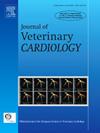Left ventricular non-compaction cardiomyopathy in eight guinea pigs (Cavia porcellus)
IF 1.3
2区 农林科学
Q2 VETERINARY SCIENCES
引用次数: 0
Abstract
Introduction
Left ventricular non-compaction cardiomyopathy (LVNC) is a rare form of myocardial disease in humans, and only three animal case reports have been published. We report on LVNC in eight guinea pigs.
Animals, Materials and Methods
Between 2018 and 2023, LVNC was identified in eight hairless Skinny breed guinea pigs (Cavia porcellus) aged 2–4.5 years that were referred for cardiac evaluation. Physical and echocardiographic examinations were performed. Echocardiographic findings were compared to those of a matched case-control group comprising eight apparently healthy guinea pigs. Seven of the eight animals with LVNC had congestive heart failure. Two underwent necropsy with cardiac histopathological examination.
Results
Four animals had a familial relationship within two litters. The other four were not related. Echocardiographic examination in all affected animals identified regions of left ventricular trabecular, spongy, non-compacted endocardium and endomyocardium. Left ventricular enlargement, systolic dysfunction, and enlargement of the left atrium were noted in seven of eight animals; pericardial effusion was present in four guinea pigs. The seven animals with congestive heart failure were treated with furosemide and pimobendan. Median survival time after diagnosis was 127 days (range: 7–270 days). Postmortem examination was conducted in two of these eight animals and presence of LVNC was confirmed.
Study limitations
Only two guinea pigs underwent necropsy, the gold standard in the diagnosis of LVNC. Thoracic radiographs were not taken and electrocardiography was not performed. Treatment choices were based on criteria used in dogs and cats.
Conclusion
Left ventricular non-compaction cardiomyopathy exists in guinea pigs. Familial relationships among affected animals suggest the possibility of a genetic etiology. Echocardiography was suitable to detect endomyocardial changes consistent with LVNC. Postmortem examination confirmed the LVNC diagnosis with additional involvement of the right ventricle in some animals.
8只豚鼠左室非压实性心肌病的研究。
左室非压实性心肌病(LVNC)是一种罕见的人类心肌疾病,仅发表了三例动物病例报告。我们报道了8只豚鼠的LVNC。动物、材料和方法:在2018年至2023年期间,在8只2-4.5岁的无毛瘦种豚鼠(Cavia porcellus)中发现LVNC,并转诊进行心脏评估。进行了身体和超声心动图检查。超声心动图结果与匹配的病例对照组(包括8只明显健康的豚鼠)进行了比较。患有LVNC的8只动物中有7只患有充血性心力衰竭。2例行尸检及心脏组织病理学检查。结果:2窝4只动物有家族关系。另外四人没有血缘关系。超声心动图检查在所有受影响的动物发现左室小梁,海绵状,非紧致的心内膜和心内膜。8只动物中有7只出现左心室增大、收缩功能障碍和左心房增大;4只豚鼠出现心包积液。7只充血性心力衰竭动物用速尿和匹莫苯丹治疗。诊断后中位生存时间为127天(范围:7-270天)。对这8只动物中的2只进行了尸检,证实存在LVNC。研究局限性:只有两只豚鼠进行了尸检,这是诊断LVNC的金标准。没有拍胸片,也没有做心电图。治疗选择基于狗和猫使用的标准。结论:豚鼠存在左室非压实性心肌病。受感染动物之间的家族关系提示可能存在遗传病因。超声心动图适于检测与LVNC相符的心内膜改变。尸检证实LVNC的诊断,并在一些动物的右心室额外累及。
本文章由计算机程序翻译,如有差异,请以英文原文为准。
求助全文
约1分钟内获得全文
求助全文
来源期刊

Journal of Veterinary Cardiology
VETERINARY SCIENCES-
CiteScore
2.50
自引率
25.00%
发文量
66
审稿时长
154 days
期刊介绍:
The mission of the Journal of Veterinary Cardiology is to publish peer-reviewed reports of the highest quality that promote greater understanding of cardiovascular disease, and enhance the health and well being of animals and humans. The Journal of Veterinary Cardiology publishes original contributions involving research and clinical practice that include prospective and retrospective studies, clinical trials, epidemiology, observational studies, and advances in applied and basic research.
The Journal invites submission of original manuscripts. Specific content areas of interest include heart failure, arrhythmias, congenital heart disease, cardiovascular medicine, surgery, hypertension, health outcomes research, diagnostic imaging, interventional techniques, genetics, molecular cardiology, and cardiovascular pathology, pharmacology, and toxicology.
 求助内容:
求助内容: 应助结果提醒方式:
应助结果提醒方式:


